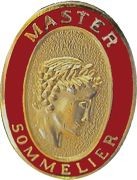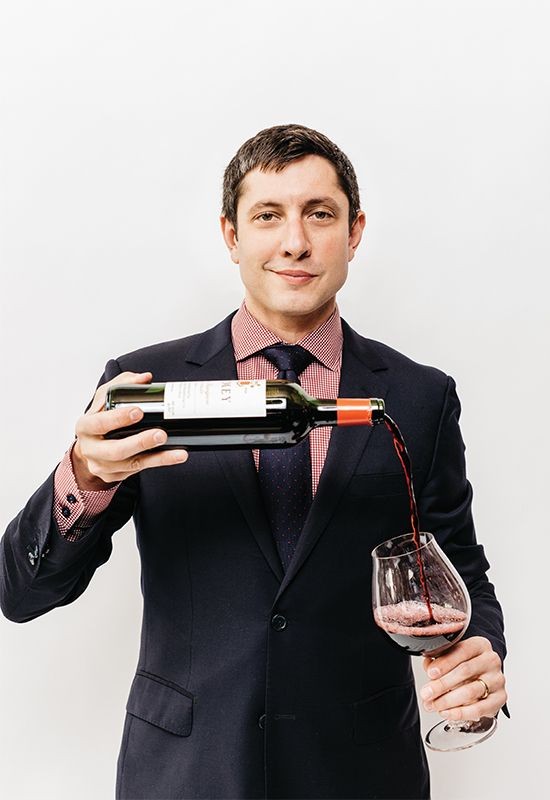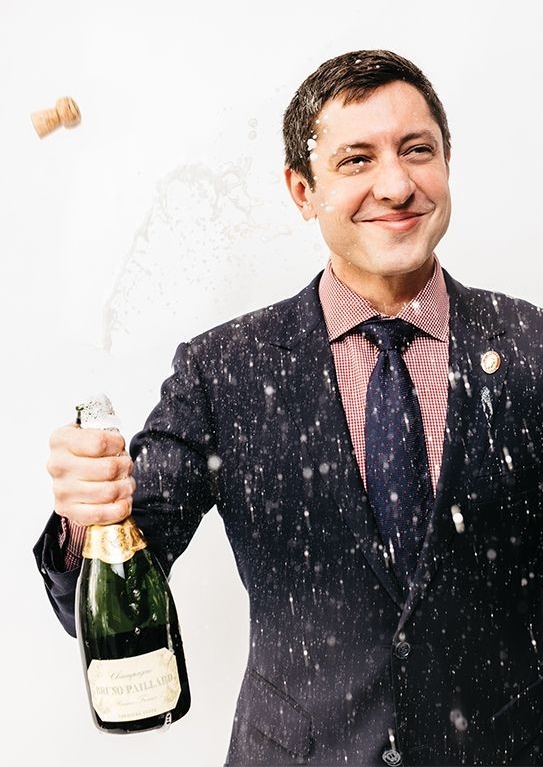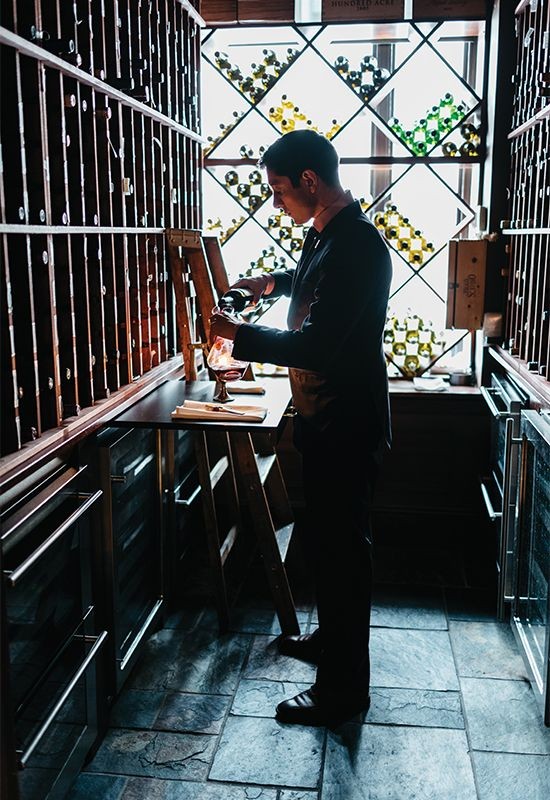Successfully blind-tasting wine requires “a bunch of smell-taste memories that I’ve built up,” said Brahm Callahan, pictured here in a wine room at Grill 23. (Photographs by Michael Piazza)

It was early afternoon on the first Monday of 2020, and Brahm Callahan was seated at a white-clothed table in the Boston restaurant Grill 23, still reeling from the holiday blitz. Just a few nights earlier, 900 guests had passed through this very dining room in celebration of New Year’s Eve. They’d popped bottles of pricy bubbly, slugged stiff cocktails, and uncorked tens of thousands of dollars worth of special-occasion wines. And each ounce of alcohol that passed through their lips and ended up on a bar tab had, in one way or another, been masterminded by Callahan.
Callahan, 35, is beverage director for Himmel Hospitality Group, whose portfolio of Boston-area restaurants also includes Harvest, Bistro du Midi, and Post 390. At each of these spots, Callahan oversees every cocktail, mocktail, beer, and bottle of wine that’s offered. The chain’s crown jewel, though, is Grill 23, the vaunted steakhouse where the wine list runs a dizzying 2,300 selections deep.
As Callahan is acutely aware, booze is big business—alcohol sales in the U.S. topped $253 billion in 2018—and a crucial component of a restaurant’s success: Beer, wine, and spirits typically account for an eatery’s highest profit margins. But alcohol isn’t just important to the bottom line. In the age of craft spirits, microbrews, and social media influencers, beverage programs are an increasingly vital part of a restaurant’s identity. And it falls on Callahan to ensure that each of the Himmel Group’s businesses rises above the fray to deliver something special to every thirsty guest who walks in the door.
“We don’t copy and paste our beverage programs,” Callahan, who wore a gray suit and a pink shirt with blue buttons, told me as we talked in Grill 23. “Each restaurant in the Himmel Group has its own personality, and I work with my teams to make sure the drink list is appropriate for the concept of the restaurant, as well as the customer base and the season.” At the Cambridge, Massachusetts, mainstay Harvest, for instance, Callahan believes that the focus on New England–themed cuisine and the smaller dining room call for cocktails that are a little different and a little more complex, such as a Sidecar with Frangelico, pumpkin spice, and cava. “And because the restaurant is in Harvard Square, where there are a lot of academics and international travelers, we can offer up a wine list that’s perhaps more esoteric than you might see in our other restaurants,” he said.
Callahan’s talent for inspired drink lists is admired by competitors and customers alike. “If you look at all the Himmel Group’s restaurants, they have phenomenal balance across their wine lists,” said Ben Oram, wine director at Boston Harbor Hotel. “Brahm’s done a great job of pulling the whole world of wine together and representing so many countries.”
Meanwhile, Kevin O’Leary, who’s better known as Mr. Wonderful, the ruthlessly critical star of ABC’s Shark Tank, gushed about “the depth of Grill 23’s domestic offerings” and Callahan’s attention to service. O’Leary, a serious wine enthusiast who belongs to the Confrérie des Chevaliers du Tastevin, a semi-secretive society of Burgundy lovers, has frequented Grill 23 for years, in part because of Callahan’s skill. “I don’t even bother looking at the wine list anymore,” he said. “I tell him or whoever on his team is working that night what I’m in the mood for, what my price range is—$150, $180 a bottle—and I let them go dig in the cellar. I’ve never been disappointed.”
As a vibrant beverage program has become ever-more crucial to a restaurant’s financial health, the role of beverage director has become quite common in the hospitality industry. But there’s something about Callahan that distinguishes him from just about every other beverage director in the world: He’s one of fewer than 300 people on earth who’s a certified master sommelier.
A few days later, Callahan invited me back to Grill 23 to show me how he shrinks the world. At the bar, he lifted up a glass containing three or so ounces of red wine, tilted it to a nearly 90-degree angle, and peered through the purple-hued liquid toward his wristwatch. “I can read the time, so that means it’s Pinot Noir, Gamay, Nebbiolo, or Sangiovese,” he said. “It could be Nerello Mascalese, it could be Grenache. You have to make the world smaller before you smell or taste it.”

(Photographs by Michael Piazza)
From there, a quick sniff narrowed it down to a Pinot or a Gamay. Then he pulled a small sip while steadily inhaling through his nostrils. “It’s a Pinot Noir,” he declared. But where was it from? He instantly ruled out South America, Europe, Australia, and South Africa, making the world smaller and smaller, until finally landing on Oregon’s Willamette Valley, circa 2016. Bingo.
The sommelier culture hews to a strict hierarchy in which master sommeliers are perched on top. They’re expected to know everything in the world there is to know about wine, from the perfect glass to pair with a filet of monkfish to soil conditions in Romania. As anyone who’s seen the acclaimed documentary Somm knows, the master sommelier test is an all-consuming experience that can take years to navigate, and that demoralizes just about everyone who tries their hand at it. The test consists of three parts: service, in which candidates are judged on their performance in a simulated restaurant experience; theory, an oral exam that probes their knowledge of history, laws, aging requirements, and anything else that’s obscure and related to wine; and a blind tasting, in which test takers must identify the precise vintage of a wine based solely on its taste, smell, and appearance. Since its inception in 1969, more people have gone to space than have successfully completed the exam. Callahan passed it at the ripe old age of 30.
Now, to be fair, asking Callahan to ID a Pinot Noir at a restaurant where he oversees the beverage program is hardly a test of his skills. It’s more like asking David Ortiz to get on base at a charity softball game. But Callahan, a baby-faced savant who still regularly gets carded at bars and liquor stores, estimates that he’s tasted more than 1 million wines at this point in his career. And he treats each one as a source of precious data points that he needs to log in his brain and be able to recall at a moment’s notice.
Successfully blind-tasting a wine is part process of elimination, part deductive reasoning, and part associative memory. “It’s a bunch of smell-taste memories that I’ve built up,” Callahan explained. “And those memories are tied to sets of information that are tied to further sets of information that are tied to further sets of information.” Novel as this skill is, Callahan assured me that it can at times feel like he’s performing a parlor trick. He’s more than happy to oblige if a dinner guest is curious, but there are much more important things he should be doing with his time—like figuring out new ways to stay ahead in Boston’s fast-evolving dining scene. But with all the cutthroat competition, harsh critics, and fickle consumers, that can be easier said than done.
Growing up in South Deerfield, Massachusetts, Callahan realized early in life that he was sensitive to the world around him in ways most people weren’t. “I was the kid who had to have all the tags and loose threads cut off my clothes and sneakers and socks or they’d drive me nuts,” he said. “I’m also the person who thinks cilantro tastes like soap, and I’ve always been sensitive to smells. I remember there was one tree in my neighborhood that when it bloomed each year I had to stop going on our family bike rides because the smell would bother me so much. It just smelled rotten, and my parents thought I was crazy because they couldn’t smell anything.”

Around age 14, Callahan landed his first restaurant job at the Deerfield Inn, a high-end hotel and eatery nestled in the foothills of the Berkshires. He served and cleared palate cleansers between courses. “My entire existence was based around scooping sorbet and putting it in a fancy glass,” he recalled with a laugh. He loved it.
At the University of Massachusetts Amherst, Callahan majored in history and worked nights as a sommelier at a nearby restaurant. He was trying to sell baby boomers $120 bottles of wine, but he looked like he was 12, so he did a bit of studying and passed the test to become a certified sommelier, the lowest rung of the ladder.
Soon after graduating from UMass, Callahan enrolled in Boston College’s master’s program in ancient history, and accepted a job running the wine program at the now-defunct Boston restaurant Excelsior. The idea was to pay his way through graduate school and then enroll in a Ph.D. program, with an eye toward ultimately becoming a professor.
As a student of history, Callahan has always admired the Roman Empire—so much so that he has a Roman centurion tattooed across his upper thigh along with “SPQG,” short for Senatus Populus que Romanus, or the Senate and People of Rome. All centurions supposedly had the letters branded or tattooed on them, he explained, as a reminder of whom they served. “It was centurions’ duty to live and die for the empire—for the greater good. But if they survived to the end of their tenure, they would be given enough land to retire and be able to live well off the empire,” he said. “And I just love the idea that if you’re willing to put more of yourself into something than you necessarily should, oftentimes it will come back to you.”
One afternoon in 2008, near the end of his master’s program, Callahan met with his advisor, Professor Robin Fleming. He had the grades and skills to pursue a Ph.D. But he was also making good money and having loads of fun working in the restaurant business. “He loved history,” Fleming told me. “But it was clear that he loved wine even more. He was already gaining a reputation as having one of the best noses in Boston.” Fleming told her student that he could always come back to academia, so why not take some time to live a life of wine?
Brahm Callahan is one of just three master sommeliers in Massachusetts. “It’s the best thing I’ve ever done,” he said. “But getting there was the worst thing I’ve ever done to myself.”
Callahan had considered wine a side hustle and a hobby, but that was starting to change. Around 2010, a friend suggested he take the advanced sommelier examination. It’s the next significant step toward becoming a master sommelier and a challenging feat in itself, one that most people fail the first time around. He passed on his first try. He was now eligible to sit for the master’s exam. Suddenly, wine had become a very serious business. Callahan spent more than a year studying, took the master’s exam…and promptly “got smoked,” he said. “I just set myself on fire during the theory portion of the exam. I was clearly not aware of the gap between where I was and where I needed to be.”
Having been humbled by his first attempt at the master’s exam, Callahan started to feel the pressure. Among the exam’s more notable rules are that you can sit for it only once a year and that you must pass each of its three parts within a three-year period. Fail to do so and you lose credit for any portions you’ve previously passed and have to start all over again. For Callahan, the clock was ticking in other ways, too: His wife was pregnant with their first child.
Acutely aware of all that was at stake, Callahan cut himself off almost entirely from the outside world. No TV, no Internet unless it was wine related, and limited social interactions. He created laminated study guides for cramming while in the shower. At the gym, his ninety minutes on the treadmill or elliptical involved studying note cards the whole time. “I was just crushing data into my brain,” he recalled. “There’s like a full eighteen-month period in 2014 and 2015 where I don’t know what happened in the world. I didn’t know there was a new governor of Massachusetts. I couldn’t have a conversation with a human being unless it was about alcohol. I just shut off.” In 2015, Callahan sat for the exam once again. This time he passed, becoming just the second master sommelier in Massachusetts. (There’s now a third in the state.) “It’s the best thing I’ve ever done,” he said. “But getting there was the worst thing I’ve ever done to myself.”
Callahan is a sommelier, of course, and that means he still gets excited about the flavor profiles of Rieslings or the aromatics of a glass of Burgundy. But these days, he’s more passionate about the business of wine. “The restaurant industry and the wine industry are changing at light speed and the traditional role of a sommelier—pairing an appropriate wine with the appropriate food, opening the bottle, and selling it—isn’t really what we’re doing anymore,” Callahan said. “I think of myself as someone who fully understands the business of wine.”

“I think of myself as someone who fully understands the business of wine,” said Brahm Callahan, pictured here at Grill 23.
As Himmel Group beverage director, Callahan buys and sells millions of dollars worth of wine from vineyards around the world—he flies 150,000 or so miles each year, to destinations like New Zealand and Argentina. He needs to know which bottles are in demand now and which bottles he can buy and lay down for ten or twenty years in the restaurant’s bunker-like cellar. He also needs to stay ahead of trends—millennials and rosé, for instance—and navigate unpredictable market forces, including President Trump’s recent threats of a 100 percent tariff on European wines. “A bottle that costs $20 today could tomorrow cost $40,” he said. “At Grill 23 we have three years worth of wine we could sell if we needed to while this whole thing works itself out. If we’re only thinking about tomorrow, then I’m not doing my job right. I have to be three, four, five steps ahead.”
Of course, not all of Callahan’s job involves jetting from vineyard to vineyard, sniffing and sipping wines while being doted on by distributors and wholesalers. A lot of his most important work involves nitty-gritty management—overseeing budgets, tracking inventory, and grooming up-and-coming talent. Under Callahan’s leadership, Grill 23’s wine program has grown to include approximately two dozen sommeliers whom he actively trains and mentors. “He’s one of those people who knows the answer to every question we have,” said Hugo Bensimon, the restaurant’s recently promoted wine director, who is himself currently studying for the master sommelier exam. Meanwhile, Callahan’s knack for sussing out and stockpiling coveted vintages has helped Grill 23 rack up enough awards to fill a trophy case. Last year, the restaurant was one of only eighty-nine in the world to earn Wine Spectator’s Grand Award.
Before I departed Grill 23, Callahan had one last thing he wanted to show me. We took an old service elevator to the basement, where Callahan led me down a winding hallway until we reached a padlocked door. Behind it, racks and racks and racks of wine greeted us.
Now, you might imagine that one of the best wine collections in New England would be housed in a state-of-the-art, climate-controlled room with laser alarms and beams of mahogany. You’d be wrong. The room was impressively bare-bones, consisting of cement walls, an old thermostat that read 52 degrees, and a couple of dozen shelves. Most people don’t give wine enough credit, Callahan said. “It’s incredibly durable. There’s a reason people have been making it and drinking it for thousands of years.”
I asked Callahan which bottle down here excited him the most, but he doesn’t play favorites. He can’t. “We have bottles that would bend most people’s minds,” he said. “We have Romanée-Conti Romanée-Conti—which is arguably the rarest bottle of wine in the world—a ’61 Lafite, and Madeira from the 1800s. But this is all so normalized to me. I’ve pretty much had everything at this point and I think that’s one of the reasons I have such a casual attitude toward wine.”
For all of Callahan’s expertise and experience, he truly does appear to have zero pretensions about wine or his career. He doesn’t care if you love canned Chardonnay or have a rack full of Two Buck Chuck in your living room. Nor does he mind the rise of Instagram influencers who’ve never studied a day in their life but are busy living that #winelife and sharing #wineporn to 40,000 followers. “If they’re drinking wine and enjoying it,” he said, “and that inspires someone else to go out and buy some wine, it’ll eventually trickle over to our side.” Callahan doesn’t romanticize wine or the path he’s taken. In his world, wine is first and foremost a business, and he’s after every bit of market share he can grab.
As we continued looking around the vast storage room, Callahan mentioned that he recently acquired a haul of Giacomo Conterno Monfortino 2012 Barolo Riserva. The 750 ml bottles will age for seven to ten years, while the magnums will age for fifteen to twenty years. “I could be long gone from here by the time those bottles are ready to be put on the list,” he said. Sometimes Callahan must be two, three, or four steps ahead of the competition. Other times, fifteen or twenty years.
Chris Sweeney is a Boston-based writer and editor whose work has appeared in Men’s Journal, Popular Mechanics, and more.
Share your thoughts: bcm@bc.edu




